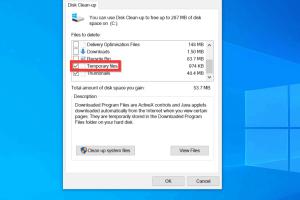How to Delete Temporary Files in Windows 10: A Quick Guide

-
Quick Links:
- Introduction
- What Are Temporary Files?
- Why Delete Temporary Files?
- How to Delete Temporary Files
- Case Studies
- Expert Insights
- FAQs
Introduction
Windows 10 users often encounter a gradual decline in system performance due to the accumulation of temporary files. These files can slow down your computer and take up valuable disk space. In this comprehensive guide, we will explore how to effectively delete temporary files in Windows 10. Whether you're a tech novice or an experienced user, our step-by-step instructions will help you clean up your system efficiently.
What Are Temporary Files?
Temporary files are files that the operating system and applications create to store data temporarily. These files may include:
- Cache files
- Installation files
- Log files
- Browser cache
- Application data
While temporary files can be useful for speeding up processes, they can accumulate over time and lead to performance issues.
Why Delete Temporary Files?
Deleting temporary files has several benefits:
- Free Up Disk Space: Temporary files can take up significant space, especially on smaller drives.
- Improve Performance: A cluttered system can slow down your PC, leading to lag and longer loading times.
- Enhanced Security: Temporary files may contain sensitive information that could be accessed by unauthorized users.
How to Delete Temporary Files
There are multiple ways to delete temporary files in Windows 10. Here, we will cover the most effective methods:
Using Disk Cleanup
Disk Cleanup is a built-in utility in Windows 10 that helps you remove unnecessary files:
- Press Windows + S and type Disk Cleanup.
- Select the drive you want to clean (usually C:).
- Click on OK to scan for files.
- In the Disk Cleanup dialog, check the box for Temporary files and any other categories you wish to delete.
- Click OK and then Delete Files to confirm.
Using Windows Settings
You can also delete temporary files directly through Windows Settings:
- Open Settings by pressing Windows + I.
- Go to System and then Storage.
- Click on Temporary files.
- Select the files you want to remove and click on Remove files.
Using Command Prompt
If you're comfortable with command line tools, you can delete temporary files using Command Prompt:
- Press Windows + X and select Command Prompt (Admin).
- Type del /q/f/s %TEMP%\* and press Enter.
- This command deletes all files in the temporary folder.
Using Third-Party Tools
For a more comprehensive cleanup, you may consider using third-party applications such as CCleaner or BleachBit. These tools offer advanced features to delete temporary files along with other junk files while maintaining system integrity.
Case Studies
To understand the impact of deleting temporary files, let’s explore a few case studies:
Case Study 1: Small Business IT Maintenance
A small business using Windows 10 experienced frequent system slowdowns. After implementing a monthly routine of deleting temporary files, they observed a performance improvement of up to 30% across their systems.
Case Study 2: Home User Experience
A home user noticed their PC taking longer to boot. By regularly cleaning temporary files, they reduced boot time from 2 minutes to under 30 seconds, significantly enhancing their computing experience.
Expert Insights
Experts recommend regular maintenance of your system to prevent performance issues. Cleaning temporary files should be a part of your routine system checks. According to a study by the Microsoft Research, systems that undergo regular cleanup have a lower failure rate and improved user satisfaction.
FAQs
1. What are temporary files in Windows 10?
Temporary files are files created by Windows and applications to store data temporarily, which can accumulate and affect system performance.
2. How often should I delete temporary files?
It is advisable to delete temporary files at least once a month to maintain optimal system performance.
3. Is it safe to delete all temporary files?
Yes, it is generally safe to delete temporary files as they are not required for regular system operations.
4. Can temporary files cause system errors?
Accumulated temporary files can lead to errors and slowdowns, affecting the overall performance of your PC.
5. What happens if I don’t delete temporary files?
Failure to delete temporary files can result in decreased performance, longer loading times, and potential system errors.
6. Will deleting temporary files remove my personal files?
No, deleting temporary files does not remove personal files such as documents, photos, or videos.
7. How do I find temporary files on my PC?
You can find temporary files in the C:\Users\
8. What are the risks of using third-party cleanup tools?
While third-party tools can be effective, they may sometimes delete files mistakenly, so it's essential to choose reputable software.
9. Can deleting temporary files improve gaming performance?
Yes, clearing temporary files can help improve gaming performance by freeing up system resources.
10. How do I automate the deletion of temporary files?
You can automate the process by scheduling Disk Cleanup in Windows Task Scheduler.
Random Reads
- How to make a video game with cmd
- How to make a tv in minecraft
- Mastering google chrome downloads
- What video game should i play
- Whatsapp usage
- How to send email on android
- How to see hours played on ps4
- How to see active network connections windows
- How to replace countertops
- How to set up disposable email address